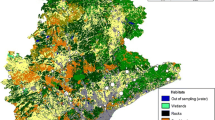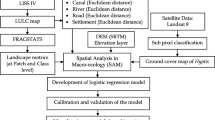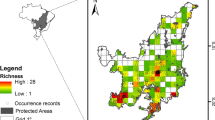Abstract
When considering the most frequent invasive exotic plants on an international scale, it is evident that the majority are ornamentals and that they were deliberately introduced in relation to landscape design. Although there are worldwide numerous lists of invasive exotic plants—which means plants that have harmful effects on native biodiversity—an assessment of the contribution of different landscape design styles on plant invasions has not been done. We used the extensive database on the history of introduction and naturalization of alien plants into natural habitats of Central Europe (Lohmeyer and Sukopp, Agriophyten in der Vegetation Mitteleuropas in: Schriftenreihe Vegetationskunde 25, 1992; Nachtrag: Braunschweiger Geobotan Arbeiten 8:179–220, 2001) to examine how many alien ornamental plants there are in the different natural habitats; and how many of them are invasive exotic plants and—in contrast—how many have not spread significantly. Also, we researched contributions by different landscape design styles to these plant invasions since medieval times. Of the estimated 12,000 alien plant species introduced into Central Europe since the Neolithic period, 279 taxa (2.3 %) are currently identified as being naturalized in natural habitats; 103 (0.86 %) of these naturalized taxa are ornamentals, and of these, 40 (0.33 %) are invasive exotic plants. Our investigation has shown a correlation between the frequency of plant invasions and changes in landscape-design styles. Evaluating the impact of plant invasions through horticulture and landscape design on native biodiversity, our study illustrates that it is significantly lower in Central Europe than in other parts of the world.


Similar content being viewed by others
References
Abendroth S, Kowarik I, Müller N, von der Lippe M (2012) The green colonial heritage: woody plants in the parks of Bandung, Indonesia. Landsc Urban Plan 106:12–22
Ahern J, Leduc E, York ML (2007) Biodiversity planning and design: sustainable practices. Landscape Architecture Foundation, New York
Bakker P, Boeve E (1985) Stinzenplanten. s-Graveland and Zutphen (in Dutch)
Baskin Y (2002) The greening of horticulture: new codes of conduct aim to curb plant invasions. Bioscience 52:464–471
Bossard CC, Randall JM, Hoshovsky MC (eds) (2000) Invasive plants of California’s wildlands. University of California Press, Berkely
Cal-IPC (2006) California invasive plant inventory. Cal-IPC Publication 2006-02. California Invasive Plant Council: Berkeley, CA. Available: www.cal-ipc.org. access 2015-12-03
Dehnen-Schmutz K, Touza J (2008) Plant invasions and ornamental horticulture: pathway, propagule pressure and the legal framework. Floric Ornam Biotechnol V:15–21
Dehnen-Schmutz K, Touza J, Perrings Ch, Williamson M (2007a) The horticulture trade and ornamental plant invasions in Britain. Conserv Biol 21:224–231
Dehnen-Schmutz K, Touza J, Perrings Ch, Williamson M (2007b) A century of the ornamental plant trade and its impact on invasion success. Divers Distrib 13:527–534
Doody BJ, Perkins HC, Sullivan JJ, Meurk CD, Stewart GH (2014) Performing weeds: gardening, plant agencies and urban plant conservation. Geoforum 54:124–136
Ellenberg H (1988) Vegetation ecology of Central Europe, 4th edn. Cambridge University Press, Cambridge
Elmqvist T, Fragkias M, Goodness J, Güneralp B, Marcotullio P, McDonald R, Parnell S, Schewenius M, Sendstad M, Seto K, Wilkinson C, Alberti M, Folke C, Frantzeskaki N, Haase D, Katti M, Nagendra H, Niemelä J, Pickett S, Redman C, Tidball K (2013) Stewardship of the biosphere in the urban era. In: Elmqvist T et al (eds) Urbanization, biodiversity and ecosystem services: challenges and opportunities: a global assessment. Springer, New York, pp 719–746
Gothein ML (1928) A history of garden art from the earliest times to the present day. In: Walter P, Wright WP (eds) Two volum. J M Dent, London
Howell C (2008) Consolidated list of environmental weeds in New Zealand. DOC Research and Development Series 292, Department of Conservation, Wellington
Hulme PE, Bremner ET (2005) Assessing the impact of Impatiens glandulifera on riparian habitats: partitioning diversity components following species removal. J Appl Ecol 43:43–50
Ignatieva M (2010) Design and future of urban biodiversity. In: Müller N, Werner P, Kelcey JG (eds) Biodiversity and design. Wiley-Blackwell, Oxford, pp 118–144
Ignatieva M, Ahrné K (2013) Biodiverse green infrastructure for the 21st century: from “green desert” of lawns to urban biophilic cities. J Archit Urban 37:1–9
Ikerd JE (2004) The globalization of agriculture: implication for sustainibility of small horticulture farms. Acta Hortic 638:399–410
Isermann M (2008) Classification and habitat characteristics of plant communities invaded by the non-native Rosa rugosa Thunb. in NW Europe. Phytocoenologia 38:133–150
Ishii HT, Manabe T, Ito K, Fujita N, Imanishi A, Hashimoto D, Iwasaki A (2010) Integrating ecological and cultural values toward conservation and utilization of shrine/temple forests as urban green space in Japanese cities. Landscape Ecol Eng 6:307–315
Jäger EJ (ed) (2011) Rothmaler Exkursionsflora von Deutschland. Gefäßpflanzen Grundband, 20th edn. Spektrum, Heidelberg (in German)
Kamysev NS (1959) A contribution to the classification of anthroprochores. Bot. Zurn. 44:1613–1616 (in Russian)
Kirmer A, Tischew S (2010) Near-natural restoration strategies in post-mining landscapes. In: Müller N, Werner P, Kelcey JG (eds) Urban biodiversity and design. Wiley-Blackwell, Hoboken, pp 539–555
Kleunen M, Dawson W, Essl F, Pergl J, Winter M, Weber E, Kreft H, Weigelt P, Kartesz J, Nishino M, Antonova L, Barcelona J, Cabezas F, Cárdenas D, Cárdenas-Toro J, Castaño N, Chacón E, Chatelain C, Ebel A, Figueiredo E, Fuentes N, Groom Q, Henderson L, Inderjit Kupriyanov A, Masciadri S, Meerman J, Morozova O, Moser D, Nickrent D, Patzelt A, Pelser P, Baptiste M, Poopath M, Schulze M, Seebens H, Shu W, Thomas J, Velayos M, Wieringa J, Pyšek P (2015) Global exchange and accumulation of non-native plants. Nature. doi:10.1038/nature14910
Kowarik I (1983) Zur Einbürgerung und zum pflanzengeographischen Verhalten des Götterbaums (Ailanthus altissima (Mill.) Swingle) im französischen Mittelmeergebiet (Bas-Languedoc). Phytocoenologia 11:389–405 (in German)
Kowarik I (1995) Time lags in biological invasions with regard to the success and failure of alien species. In: Pyšek P, Prach K, Rejmánek M, Wade PM (eds) Plant invasions - general aspects and special problems. SPB Academic Publishing, Amsterdam, pp 15–38
Kowarik I (2005) Urban ornamentals escaped from cultivation. In: Gressel J (ed) Crop Fertality and Volunteerism. CRC Press, Boca Raton, pp 97–121
Kowarik I (2010) Biologische invasionen: neophyten und neozoen in mitteleuropa, 2nd edn. with contr. W Rabitsch, Stuttgart, Ulmer (in German)
Kümmerling M, Müller N (2012) The relationship between landscape design style and conservation value of parks: a case study of a historical park in Weimar, Germany. Landsc Urban Plan 107:111–117
Landolt E (2011) Zurich. In: Kelcey JG, Müller N (eds) Plants and habitats of European Cities. Springer, New York, pp 547–577
Lehan NE, Murphy JR, Thorburn LP, Bradley BA (2013) Accidental introductions are an important source of invasive plants in the continental United States. Am J Bot 100:1287–1293
Lodge DM (1993) Biological invasions: lessons for ecology. Trends Ecol Evol 8:133–137
Lohmeyer W, Sukopp H (1992) Agriophyten in der Vegetation Mitteleuropas. Schriftenreihe Vegetationskunde 25 (in German)
Lohmeyer W, Sukopp H (2001) Agriophyten in der Vegetation Mitteleuropas 1. Nachtrag. Braunschweiger Geobotan Arbeiten 8:179–220 (in German)
Lovell ST, Johnston DM (2009) Designing landscapes for performance based on emerging principles in landscape ecology. Ecol Soc 14:44
Mack R (2005) Predicting the identity of plant invaders: future contributions from horticulture. HortScience 40:1168–1174
Mack R, Erneberg M (2002) The United States naturalized flora: largely the product of deliberate introductions. Ann Missouri Bot Gard 89:176–189
Martin PH, Canham CD, Marks PL (2009) Why forests appear resistant to exotic plant invasions: intentional introductions, stand dynamics, and the role of shade tolerance. Front Ecol Environ 7:142–149
Müller N, Okuda S (1998) Invasion of alien plants in floodplains - a comparison of Europe and Japan. In: Starfinger U, Edwards K, Kowarik I, Williamson M (eds) Plant Invasions. Backhuys Publishers, Leiden, pp 321–332
Müller N, Ignatieva M, Nilon ChH, Werner P, Zipperer WC (2013) Patterns and trends in urban biodiversity and landscape design. In: Elmqvist T et al (eds) Urbanization, biodiversity and ecosystem services: challenges and opportunities: a global assessment. Springer, New York, pp 123–174
Niemiera AX, von Holle B (2009) Invasive plant species and the ornamental horticulture industry. In: Inderjit A (ed) Management of invasive weeds. Springer, Dordrecht, pp 167–187
Otte A, Eckstein L, Thiele J (2007) Heracleum mantegazzianum in its primary distribution range of the western greater Kaukasus. In: Pyšek P, Cock MJW, Nentwig W, Ravn HP (eds) Ecology and management of giant hogweed (Heracleum mantegazzianum). CAB International, Wallingford, pp 20–41
Pyšek P, Sádlo J, Mandák B (2002) Catalogue of alien plants of the Czech Republic. Preslia 74:97–186
Reichard SE (1997) Prevention of invasive plant introductions on national and local levels. In: Luken JA, Thieret JA (eds) Assessment and management of plant invasions. Springer, New York, pp 215–227
Reichard SE, White P (2001) Horticulture as a pathway of invasive plant introductions in the United States. Bioscience 51:103–113
Richardson DM, Pyšek P (2006) Plant invasions: merging the concepts of species invasiveness and community invisibility. Prog Phys Geogr 30:409–431
Richardson DM, Pyšek P, Rejmanek M, Barbour M, Panetta D, West C (2000) Naturalization and invasion of alien plants: concepts and definitions. Biodivers Res 6:93–107
Robert F, Brzuszek RF, Harkess RL, Mulley SJ (2007) Landscape architects’ use of native plants in the southeastern United States. Hort Technol 17:78–81
Ronse A, Braithwaite ME (2012) Seed for growing under trees’: the source of wood lawn neophytes in the parkland of Scottish mansion houses. New J Bot 2:149–154
Scotton M, Kirmer A, Krautzer B (eds) (2012) Practical handbook for seed harvest and ecological restoration of species rich-grasslands. Cleup Editore, Italy
Sukopp H, Kowarik I (2008) Stinsenpflanzen und deren agriophytische Vorkommen. Ber. Institut Landschafts-Pflanzenökologie Univ. Hohenheim 17:81–90 (in German)
Sukopp H, Schneider Ch (2013) Vogelfutterpflanzen in Berlin. Verh Bot Ver Berlin Brandenburg 146:5–21 (in German)
Thellung A (1912) La flora adventice de Montpellier. Mem Soc Nation Sci Nat Math 38:57–728 (in French)
Turner T (2005) Garden history: philosophy and design, 2000 BC–2000 AD. Spon Press Taylor and Francis Group, London, New York
Vitousek PM, D’Antonia CM, Loope LL, Rejmanek M, Westbrooks R (1997) Introduced species: a significant component of human-caused global change. N Z J Ecol 21:1–16
Weber E (2003) Invasive plant species of the world: a reference guide to environmental weeds. CABI Publishing, Cambridge
Werner PA, Bradbury JK, Gross RS (1980) The biology of Canadian weeds. 45. Solidago canadensis L. Can J Plant Sci 60:1393–1409
Woerdemann T (2008) Tuinieren met stizenplanten: vreugde van een vroege lente. Dieren, Diepenmaat (in Dutch)
Zavagno F, d’Auria G (2001) Synecology and dynamics of Amorpha fruticosa communities in Po plain, Italy. In: Brundu J, Camarda I, Child L, Wade M (eds) Plant invasions: species ecology and ecosystem management. Backhuys Publishers, Leiden, pp 175–182
Acknowledgments
For comments to previous versions of this paper, we are grateful to Arthur Brande (Berlin, Germany), John G. Kelcey (Bor U Tachova, Czech Republic), Martin Kümmerling (Erfurt, Germany), Glenn Stewart (Christchurch, New Zealand), Ulrich Sukopp (Bonn, Germany), Wayne Zipperer (Gainsville, Florida), and two anonymous reviewers. John G. Kelcey improved the English version of the manuscript, and Martin Kümmerling prepared the figures.
Author information
Authors and Affiliations
Corresponding author
Appendices
Appendix 1
See Table 10.
Appendix 2
See Table 11.
Rights and permissions
About this article
Cite this article
Müller, N., Sukopp, H. Influence of different landscape design styles on plant invasions in Central Europe. Landscape Ecol Eng 12, 151–169 (2016). https://doi.org/10.1007/s11355-015-0288-9
Received:
Revised:
Accepted:
Published:
Issue Date:
DOI: https://doi.org/10.1007/s11355-015-0288-9




